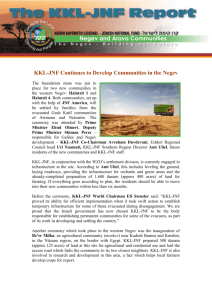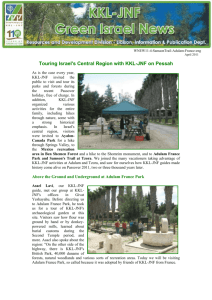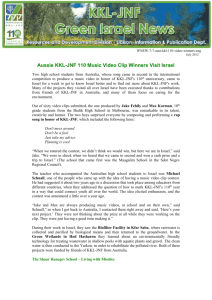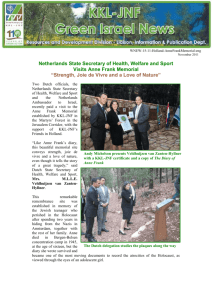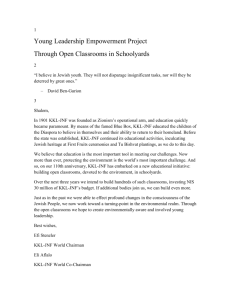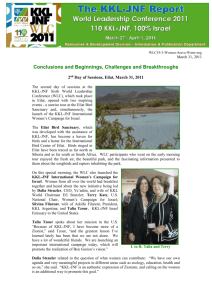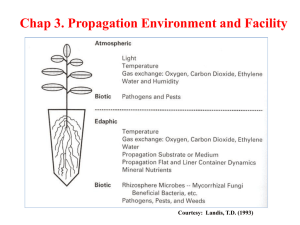Document1
advertisement
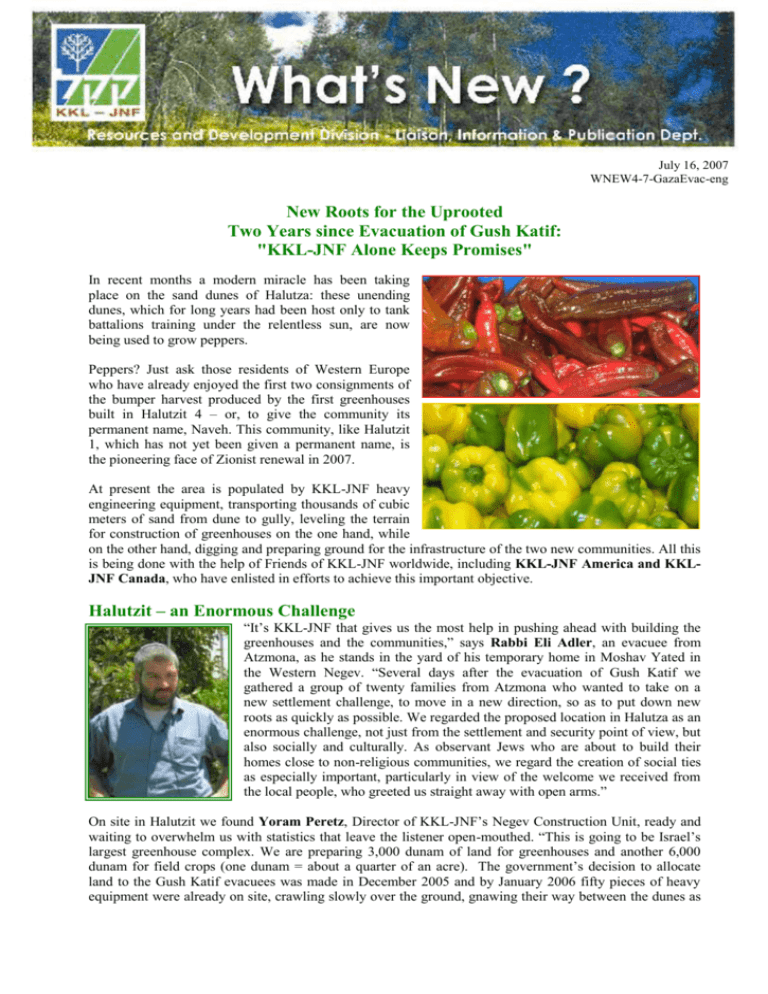
July 16, 2007 WNEW4-7-GazaEvac-eng New Roots for the Uprooted Two Years since Evacuation of Gush Katif: "KKL-JNF Alone Keeps Promises" In recent months a modern miracle has been taking place on the sand dunes of Halutza: these unending dunes, which for long years had been host only to tank battalions training under the relentless sun, are now being used to grow peppers. Peppers? Just ask those residents of Western Europe who have already enjoyed the first two consignments of the bumper harvest produced by the first greenhouses built in Halutzit 4 – or, to give the community its permanent name, Naveh. This community, like Halutzit 1, which has not yet been given a permanent name, is the pioneering face of Zionist renewal in 2007. At present the area is populated by KKL-JNF heavy engineering equipment, transporting thousands of cubic meters of sand from dune to gully, leveling the terrain for construction of greenhouses on the one hand, while on the other hand, digging and preparing ground for the infrastructure of the two new communities. All this is being done with the help of Friends of KKL-JNF worldwide, including KKL-JNF America and KKLJNF Canada, who have enlisted in efforts to achieve this important objective. Halutzit – an Enormous Challenge “It’s KKL-JNF that gives us the most help in pushing ahead with building the greenhouses and the communities,” says Rabbi Eli Adler, an evacuee from Atzmona, as he stands in the yard of his temporary home in Moshav Yated in the Western Negev. “Several days after the evacuation of Gush Katif we gathered a group of twenty families from Atzmona who wanted to take on a new settlement challenge, to move in a new direction, so as to put down new roots as quickly as possible. We regarded the proposed location in Halutza as an enormous challenge, not just from the settlement and security point of view, but also socially and culturally. As observant Jews who are about to build their homes close to non-religious communities, we regard the creation of social ties as especially important, particularly in view of the welcome we received from the local people, who greeted us straight away with open arms.” On site in Halutzit we found Yoram Peretz, Director of KKL-JNF’s Negev Construction Unit, ready and waiting to overwhelm us with statistics that leave the listener open-mouthed. “This is going to be Israel’s largest greenhouse complex. We are preparing 3,000 dunam of land for greenhouses and another 6,000 dunam for field crops (one dunam = about a quarter of an acre). The government’s decision to allocate land to the Gush Katif evacuees was made in December 2005 and by January 2006 fifty pieces of heavy equipment were already on site, crawling slowly over the ground, gnawing their way between the dunes as they constructed a main access road to the areas where the greenhouses and the communities would be built. Until that day in January 2006 the only things to be seen in this area were tank units on maneuvers and a few flocks grazing on the sparse vegetation. Today working greenhouses have already marketed two consignments of produce since we turned the first greenhouse areas over to the Atzmona evacuees in March 2006. They planted crops in June of last year, and the first peppers left here in December 2006.” If everything were left up to the settlers and KKL-JNF, the Halutzit communities’ first permanent homes would probably already be standing on site. “The problem is that they – the settlers – are moving faster than the State,” says Elisha Mizrahi, Director of KKL-JNF’s Southern Region. “We’ve been busy at this site for a year and eight months, ever since we began the main work about the same time as we started preparing the ground for the greenhouses at Moshav Mavki’im. The fact that KKL-JNF systems can swing into action so quickly helped us to get started with a minimum of delay. But we’re paying a high price in terms of the precious time required for the bureaucratic procedures. Yaron and I are frustrated because, even though the next stages of our task are ready for implementation, we can’t move ahead because the statutory areas procedure has not been completed. I think I’m speaking for all those personally involved in the resettlement and rehabilitation of the evacuees when I call for as much effort as possible to be made to hurry along the next stages of work at the site.” In the hut that serves as KKL-JNF’s project administration “office” sits Noam Rein, a member of the Yated-Atzmona gar’in (new settlement core group) who laughs in agreement with Elisha Mizrahi's comments. “The members of the communities here are imbued with a desire to create, build, and break out of the shadow of the evacuation and displacement, so that they can grow. I regard this as a mission in which the whole country should take part. The Israeli nation is not founded only on tanks. What’s happening here is the result of a shared ability to make things happen. The Jewish People has acted wisely in creating superb instruments for itself, such as KKL-JNF. The question of whether the bulldozer will destroy homes or build them depends on the hand and spirit that guide it. I was born in Degania, and I still possess the remains of the pioneering spirit that was part of kibbutz ideology. Our displacement has resulted in the construction of a second storey on the foundations laid by Ben-Gurion and his generation. What you see here is not rehabilitation, but a process of construction born out of the understanding that sacred and secular are all one to the spirit of the Jewish People. The little cog in the works has begun to turn the bigger wheels. We are motivated by a new message that we want to bring to the Jewish nation. But in order to deliver a message, you need an organization that can implement it, and only KKL-JNF can get such a huge process moving.” In the course of the past year KKL-JNF equipment at the Halutzit sites has moved some three million cubic meters of earth from one place to another in order to prepare the ground for the greenhouses and construct the main roads through the dunes. So far around 3,000 dunam of land have been prepared out of an area of 15,000 dunam, most of which is slated for agricultural use. Infrastructures for the first 400 dunam for Halutzit 4 and another 300 dunam for Halutzit 1 are in progress. In the meantime, the human factor has been pushing ahead, too. Rabbi Adler says that the nucleus of people wishing to join the Naveh community has increased fourfold in recent months. Sixty young families have joined those awaiting construction of their permanent homes in a community that will include religious educational institutions and even a yeshiva high school, and whose population will engage in agriculture on the one hand and education and Torah study on the other. "Doing the Impossible and the Unbelievable" In KKL-JNF’s Gilat Nursery on the outskirts of Ofakim, large numbers of trees have been waiting for the past two years. They were uprooted from the orchards of the Torah and Land Institute in Kfar Darom in a combined rescue operation carried out by KKL-JNF and the evacuees themselves and replanted in temporary “hostels” at the Gilat Nursery. In the rush to save them, even varieties that hardly ever withstand transplanting were moved. A minority of these did not survive, and today their withered remains can still be seen standing upright in the nursery. But most of them, including deciduous fruit trees that do not normally overcome the vicissitudes of transplantation are flourishing, flowering and producing fruit in their temporary accommodation, waiting for the evacuees to move into their permanent homes. Elisha Mizrahi and Gilat nurserywoman Aliza Damari examine the trees, which have been marked with orange ribbons – the symbol of opposition to the evacuation – as attentively as if they were their own children. “The desire to use these trees to create a sense of continuity is highly symbolic,” says Aliza. “Just as people’s lives go on, so, too, the trees will eventually be replanted in their new home.” Elisha Mizrahi adds. “I believe that this is the very essence of Zionism – doing the impossible and the unbelievable. We are just waiting for the moment when the trucks and bulldozers that moved the trees out of Gush Katif come into the nursery and take the trees back to the reconstructed Torah & Land Institute, which teaches people about the connection between the Torah, the Land of Israel and its trees.” A Ray of Hope and a Sense of Unity Even though hardly any of the Gush Katif evacuees have as yet found new permanent homes, some farmers from Ganei Tal are already seeing the fruits of their labors, despite the stalemate as far as government aid and adequate compensation for the evacuees are concerned. Of all former residents of Gush Katif, the population of Ganei Tal has remained the most cohesive and united group. All of them live in the temporary neighborhood built for them in Yad Binyamin, the east of Gedera, and all are waiting for work to start on the construction of their permanent homes on the plots allotted to Ganei Tal in the area adjacent to Kibbutz Hafetz Hayim. Nonetheless, for the past two years they have been engaged in intensive hi-tech agriculture in the greenhouses that sprung up overnight amongst the dunes north of Moshav Mavki’im, which lies to the south of Ashkelon. In the week of the second anniversary of the eviction of the Gaza communities and the pain the evictees have endured ever since, the magnificent Mavki’im greenhouses provided a ray of hope and a sense of unity. This is thanks to the persistence of wonderful people like Ronit Balaban and Asaf Assis and their partners in tremendous efforts: the Jewish community of Vancouver, Canada who, in the course of a single evening, raised half a million dollars to fund a considerable part of the infrastructure for the Mavki’im greenhouses. Two modest ceremonies were held in honor of the community and of Mr. Ben Dyson, who put the full weight of his 100 years behind the campaign, in commemoration of Vancouver Jewish Community’s role in this enthusiastic renewed Zionist settlement enterprise. On the very same day that we witnessed the miracle taking shape among the Halutza sand dunes on the borders of Egypt and the Gaza Strip, we attended both these ceremonies. Here, too, as in Halutza, no one tried to hide the serious problems that have accompanied the successes. “I would never have believed that I would be put in the position of having to sue the State,” says Ronit Balaban, who, because of the way she has continued to run her garden plant export nursery in its new location, has already become a symbol of determination and willpower. “The sight of KKL-JNF equipment preparing the ground here was simply amazing. What we have been doing here is trying to save our life’s work, and KKL-JNF was here for us in the most wonderful and astonishing manner, together with its Friends throughout the world, and especially in Canada. However, the government has still not realized that it is impossible to reconstruct one’s life’s work on the basis of compensation we have been offered. We are deeply in debt and any help from any source is a blessing and a lifesaver as far as we are concerned. Today I feel that we and the Vancouver community are a family. The first time they came to visit, they were guests. The second time they were already friends, and now, on this third visit, they’re part of the family.” “I don’t know if there’s any other organization in operation that could have done what KKL-JNF did enabling us to start using ten dunam of greenhouses, then another ten dunam, while at the same time preparing the land at Mavki’im. But they managed to do it, so that we wouldn’t have to waste time and so that we could move hundreds of thousands of saplings from Gush Katif to Mavki’im overnight and use the Mavki’im irrigation system the following morning.” In these words Asaf Assis described what happened to him and his young geranium plants and to Orit Balaban and her myrtle saplings. A Portrait of Optimism KKL-JNF emissary to Vancouver Aharon Lapidot brought over a present for members of the Ganei Tal community: a picture painted by Laurie Goldberg of the Vancouver Jewish Community, based on her impression of work on the infrastructure for the Gaza evacuees as portrayed in KKL-JNF publicity material she had seen. Laurie Goldberg has never visited the site, but there can be no doubts about the composition she chose to depict or the optimism expressed in every brush stroke. On the night that the Vancouver Jewish Community celebrated Ben Dyson’s 100th birthday – his youthful pioneering spirit undiminished – all those present at the dinner signed the border of the picture that had been presented to the former residents of Ganei Tal to commemorate the second anniversary of their evacuation from their community and their homes. In a modest ceremony in the shade of the old sycamore tree next to the fence around the greenhouses in Mavki’im, Ashkelon Council representative Yochanan Shlomo said, “Wherever we turn anywhere in this country – and in the Western Negev in particular – we see the very best side of Israel. We see KKL-JNF, busy preparing land for greenhouses and infrastructures for new settlement, paving security roads for existing communities, rehabilitating rivers and planting forests and woodland. I myself, as a former evictee and resident of Netiv HaAsara, would like to tell you all: only after you begin to market your produce once more will you have rehabilitated yourselves after the trauma of evacuation.” Another moving ceremony, attended by dozens of Ganei Tal residents, was held in Yad Binyamin. “On this spot courage and heroism, strength and heart are united,” said KKL-JNF Co-Chairman Avraham Duvdevani, who can take pride in many years of productive settlement activity. “All we have done is to help you. The courage and heroism came from you, yourselves, who are going to settle here. Ganei Tal has a uniquely cohesive community spirit and this togetherness is its greatest strength, just as the nation’s strength lies in its unity. When any one of our communities is in trouble and distress, not only do we feel its pain – so, too, do our brothers over there in beautiful Canada. Out of this sense of identification the desire to help is born, and it is this desire that we welcome, and for which we give thanks today.” For Articles, comments or use please contact Ahuva Bar-Lev KKL-JNF – Information and Publications Email: ahuvab@kkl.org.il Phone: 972-2-6583354 Fax:972-2-6583493 www.kkl.org.il/eng
